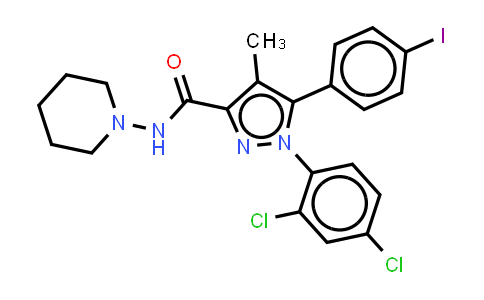| Chemical Name |
AM251 |
| CAS Number |
183232-66-8 |
| MDL Number |
MFCD01861181 |
| Molecular Formula |
C22H21Cl2IN4O |
| Molecular Weight |
555.24 |
Introduction of 183232-66-8 :
AM251 is a selective cannabinoid (CB)1 receptor antagonist with IC50 of 8 nM, also acts as an agonist at micromolar concentration. IC50 & Target: IC50: 8 nM (CB1 receptor)[1] In Vitro: AM251 is a CB1 receptor antagonist/inverse agonist. AM251 produces an agonist response in HEK293 cells, similar to that found in the yeast expression system[2]. AM-251 reduces cholesteryl ester synthesis in unstimulated and acetylated LDL-stimulated Raw 264.7 macrophages, CB2+/+ and CB2-/- peritoneal macrophages[3]. In Vivo: The CB1 antagonist AM251 (3 mg/kg, i.p.) decreases capsaicin-evoked nocifensive behavior (F1,18=28.45, p<0.0001). This suppressive effect is genotype dependent (F1,18=14.83, p<0.01), and the interaction between the effects of genotype and AM251 approached significance (F1,18=4.704, p=0.0587). Planned comparisons reveal that AM251 reduces nocifensive behaviors in fatty-acid amide hydrolase (FAAH) KO mice (p<0.01) but fails to alter nocifensive behavior in WT mice (p>0.2) relative to their respective vehicle controls. AM251 (3 mg/kg, i.p.) reduces the duration of heat hypersensitivity in FAAH KO (F1,9=21.43, p<0.01) but not WT mice (p>0.3). AM251 suppresses capsaicin-evoked heat hypersensitivity in a time-dependent manner in FAAH KO (F5,9=4.349, p<0.01) but not in WT mice (p>0.3). Post-hoc analysis reveals that FAAH KO mice receiving vehicle (i.p.) display heightened thermal hypersensitivity at 30 (p<0.05), 60 (p<0.05), and 90 (p<0.001) minutes post-capsaicin in comparison to FAAH KO animals receiving AM251)[4]. One-way ANOVA shows that AM251 (AM-251) injected into the rats significantly decreases both of the percentage of entries in the open arms and time spent in the open arms, compare to controls. The Tukey-Kramer test analysis reveals a significant reduction for the doses of 1 mg/kg (P<0.05) and 5 mg/kg (P<0.01) compare to control rats in the time spent in the open arms. Also, AM251 significantly decreases percentage of entries in the open arms for the doses of 1 and 5 mg/kg (P<0.05)[5].
| Purity |
NLT 98% |
| Storage |
at 20ºC 2 years |
*The above information is for reference only.
